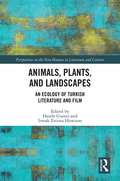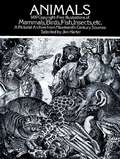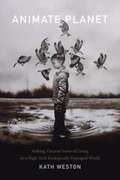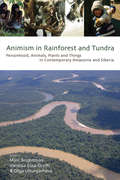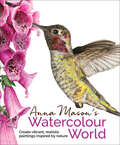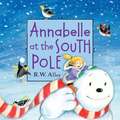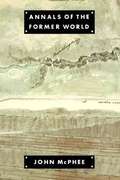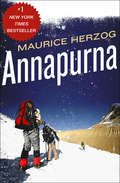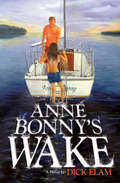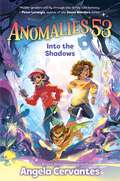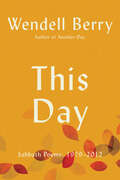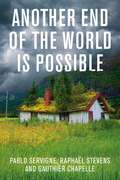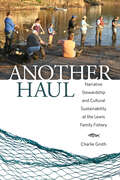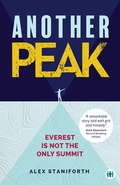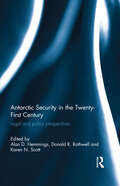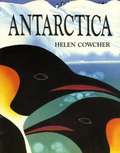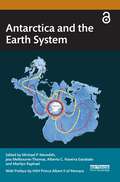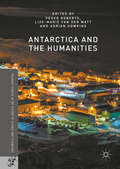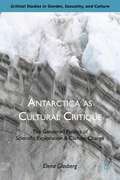- Table View
- List View
Animals, Plants, and Landscapes: An Ecology of Turkish Literature and Film (Perspectives on the Non-Human in Literature and Culture)
by Hande Gurses Irmak Ertuna HowisonThe landscape of Turkey, with its trees and animals inspires narratives of survival, struggle and escape. Animals, Plants, and Landscapes: An Ecology of Turkish Literature and Film, will be the first major study to offer fresh theoretical insight into this landscape, by offering a collection of analyses of key texts of Turkish literature and cinema. Through discussion of both classical and contemporary works, this volume, paves the way for the formation of a ecocritical canon in Turkish literature and the rise of certain themes that are unique to Turkish experience. Snakes, fishermen and fish who catch men, porcupines contemplating on human agency, dogs exiled on an island and men who put dogs to fights, goat herders and windy steppes of Anatolia are all agents in a territory that constantly shifts. The essays included in this volume demonstrate the ways in which the crystallized relations between human and non-human form, break, and transform.
Animals: 1,419 Copyright-Free Illustrations of Mammals, Birds, Fish, Insects, etc (Dover Pictorial Archive)
by Jim HarterSelected for its visual impact and ease of use, this outstanding collection of wood engravings presents over 1,000 species of animals in extremely lifelike poses. Includes many different versions of familiar mammals, birds, reptiles, amphibians, fish, insects, and other invertebrates such as spiders, crabs, squid, earthworms, and more. Captions provide modern common-name identifications.
Animate Planet: Making Visceral Sense of Living in a High-Tech Ecologically Damaged World
by Kath WestonIn Animate Planet Kath Weston shows how new intimacies between humans, animals, and their surroundings are emerging as people attempt to understand how the high-tech ecologically damaged world they have made is remaking them, one synthetic chemical, radioactive isotope, and megastorm at a time. Visceral sensations, she finds, are vital to this process, which yields a new animism in which humans and "the environment" become thoroughly entangled. In case studies on food, water, energy, and climate from the United States, India, and Japan, Weston approaches the new animism as both a symptom of our times and an analytic with the potential to open paths to new and forgotten ways of living.
Animism In Rainforest And Tundra
by Vanessa Elisa Grotti Marc Brightman Olga UlturgashevaAmazonia and Siberia, classic regions of shamanism, have long challenged 'western' understandings of man's place in the world. By exploring the social relations between humans and non-human entities credited with human-like personhood (not only animals and plants, but also 'things' such as artifacts, trade items, or mineral resources) from a comparative perspective, this volume offers valuable insights into the constitutions of humanity and personhood characteristic of the two areas. The contributors conducted their ethnographic fieldwork among peoples undergoing transformative processes of their lived environments, such as the depletion of natural resources and migration to urban centers. They describe here fundamental relational modes that are being tested in the face of change, presenting groundbreaking research on personhood and agency in shamanic societies and contributing to our global understanding of social and cultural change and continuity.
Anna Mason's Watercolour World: Create Vibrant, Realistic Paintings Inspired by Nature
by Anna MasonLearn to find inspiration, plan your approach, and create stunning watercolour paintings inspired by the natural world.Anna’s vibrant, detailed and uplifting watercolours have earned her worldwide recognition. In this, her second book, she goes beyond flowers to explore her inspirations from across the natural world, including fruit, birds and animals. The book gives you a very personal insight into Anna’s way of working; with clarity and warmth she will help you find inspiration, choose scale and composition, see things correctly and work with discipline and flow until you produce fabulous work of your own. Packed with advice and inspiring finished pieces, this gorgeous book guides the reader through Anna’s method of working with a variety of beautiful step-by-step projects and exercises. It is suitable for beginners or for more experienced artists looking to refine their style or try some new techniques.“This book is glorious in every sense, from the beautiful cover to the absolutely stunning paintings throughout the book, this is something to bring joy on the dullest of days. . . . This beautiful book is packed full of helpful advice, how to garden, how to photograph, and how to paint from those photographs, how to understand colour, form and texture.” —My Creative Notebook“This engaging guide to painting a wide variety of natural subjects is packed with information and inspiration. . . . This is an intriguing, enthralling and thoroughly enjoyable book.” —The SAA Catalogue
Anna and the Ice Troll
by C. L. ClickardUntil she finishes her laundry, Anna won't be chased away by an ice troll!
Anna, Grandpa, and the Big Storm
by Carla StevensThe whole city of New York is blanketed by snow. But it's the final day of the spelling bee, and snow or no snow. Anna has to get to school. It's not as easy as she expected!
Annabel the Actress, Camping It Up
by Ellen ConfordAnnabel is dead set on becoming a famous actress. When the camp play calls for auditions, she is only too happy to try out for the big part. Annabel clinches it with her blood-curdling screams, and she thinks this gig just might be her big break. But soon she learns there's more to the acting life than fame and fortune. And when a garden snake worms his way onstage opening night, it's up to Annabel to make sure that the show must go on!
Annabelle at the South Pole
by R. W. AlleyAnnabelle is trapped inside on a cold, wintry afternoon with her brothers and sister. When they won’t stop pestering her, she sets off into the snowy backyard in search of adventure, and soon finds herself at the South Pole in the company of an abominable (but adorable) snowman. This magical winter story joins Clark in the Deep Sea, Gretchen Over the Beach, and Mitchell on the Moon in a four-book series that celebrates the power of imagination, created by the veteran children’s book illustrator R. W. Alley.
Annals of the Former World
by John McpheeJohn McPhee describes a cross-section of North America and comes to an understanding not only of the science but of the style of the geologists he traveled with. Completed in four stages under the collected title: Annals of the Former World. <P><P> Winner of the Pulitzer Prize.
Annapurna: The First Conquest of an 8,000-Meter Peak (Lyons Press Ser.)
by Maurice HerzogOne of Sports Illustrated&’s Top 100 Sports Books of All Time: A gripping firsthand account of one of the most daring climbing expeditions in history. #1 New York Times Bestseller Annapurna I is the name given to the 8,100-meter mountain that ranks among the most forbidding in the Himalayan chain. Dangerous not just for its extreme height but for a long and treacherous approach, its summit proved unreachable until 1950, when a group of French mountaineers made a mad dash for its peak. They became the first men to accomplish the feat, doing so without oxygen tanks or any of the modern equipment that contemporary climbers use. The adventure nearly cost them their lives. Maurice Herzog dictated this firsthand account of the remarkable trek from a hospital bed as he recovered from injuries sustained during the climb. An instant bestseller, it remains one of the most famous mountaineering books of all time, and an enduring testament to the power of the human spirit.
Anne Bonny's Wake: Maggie And Hersh Adventure Series (Maggie and Hersh #1)
by Dick ElamThis 1980s Carolina coast thriller &“channels all the danger, intrigue, and thrills of a pirate&’s life at sea for a twentieth-century criminal mystery&” (Forward Reviews).On an old sailboat named for his departed wife—as well as a legendary pirate—criminal justice professor Hershel Barstow is saying his final goodbye with a trip through the North Carolina Intercoastal Waterway. He expects his solo trip aboard the Anne Bonny to be a quiet one. Then the mysterious and seductive Maggie Adelaide Moore appears in the water and climbs aboard. His reluctant offer to help the distressed woman soon brings trouble, entangling Hershel with a dangerous drug cartel. Now Hershel needs to call on old friends from his CIA days to stay safe and riddle out Maggie's mysterious past. In the weathered Anne Bonny, enemies could be lurking behind every river bend. Now Hershel must navigate his way through deadly waters on a quest for truth, safety, and justice.
Annuals
by Ted Martson Andrew LawsonArranged like an encylopedia, Annuals discusses the variety, proper care and importance of growing annual plants.
Anomalies 53: Into the Shadows (Anomalies 53 #1)
by Angela CervantesA Junior Library Guild Gold Standard Selection!It’s one thing to leave the world behind; it’s another thing when you can never return. Next door to the notorious Area 51 sits Area 53, the underground lab where the government secretly holds “the anomalies.” These are the Earth-born mythical and magical creatures—fairies, wyverns, manticores, and more—that have been captured and brought in for careful study. It’s also where eleven-year-old Ollie Robles and his best (and only) friend, Garen Jackson, the kids of Area 53’s lead researchers, have grown up. They’ve lived safely within these cement-and-steel halls their whole lives . . . that is, until the day that Ollie and Garen accidentally free six anomalies: two sprites, a wyvern, a baby manticore, a llamacorn, and a golem named Henry. Now it’s up to Ollie and Garen to chase down the anomalies and bring them back home. It’s a daring, high-stakes adventure into a world full of magical creatures, dark corners, and surprising revelations as told in the way only Pura Belpré Honor–winning author and master storyteller Angela Cervantes can.
Another Day: Sabbath Poems 2013-2023
by Wendell BerryA new collection of poems and the companion volume to the popular bestseller This Day, Wendell Berry's Another Day is another stunning contribution to the poetry canon from one of America's most beloved writersA companion to his beloved volume This Day and Wendell Berry's first new poetry collection since 2016, this new selection of Sabbath Poems are filled with spiritual longing and political extremity, memorials and celebrations, elegies and lyrics, alongside the occasional rants of the Mad Farmer, pushed to the edge yet again by his compatriots and elected officials.With the publication of this new edition, it has become increasingly clear that the Sabbath Poems have become the very heart of Berry&’s work.
Another End of the World is Possible: Living the Collapse (and Not Merely Surviving It)
by Pablo Servigne Gauthier Chapelle Raphaël StevensThe critical situation in which our planet finds itself is no longer in doubt. Some things are already collapsing while others are beginning to do so, increasing the possibility of a global catastrophe that would mean the end of the world as we know it. As individuals, we are faced with a daily deluge of bad news about the worsening situation, preparing ourselves to live with years of deep uncertainty about the future of the planet and the species that inhabit it, including our own. How can we cope? How can we project ourselves beyond the present, think bigger and find ways not just to survive the collapse but to live it? In this book, the sequel to How Everything Can Collapse, the authors show that a change of course necessarily requires an inner journey and a radical rethinking of our vision of the world. Together these might enable us to remain standing during the coming storm, to develop a new awareness of ourselves and of the world and to imagine new ways of living in it. Perhaps then it will be possible to regenerate life from the ruins, creating new alliances in differing directions – with ourselves and our inner nature, between humans, with other living beings and with the earth on which we dwell.
Another Haul: Narrative Stewardship and Cultural Sustainability at the Lewis Family Fishery (Folklore Studies in a Multicultural World Series)
by Charlie GrothLewis Island in Lambertville, New Jersey, is the site of the Lewis Fishery, the last haul seine American shad fishery on the nontidal Delaware River. The Lewis family has fished in the same spot since 1888 and operated the fishery through five generations. The extended Lewis family, its fishery’s crew, and the Lambertville community connect with people throughout the region, including environmentalists concerned about the river. It was a Lewis who raised the alarm and helped resurrect a polluted river and its biosphere. While this once exclusively masculine activity is central to the tiny island, today men, women, and children fish, living out a sense of place, belonging, and sustainability.In Another Haul: Narrative Stewardship and Cultural Sustainability at the Lewis Family Fishery, author Charlie Groth highlights the traditional, vernacular, and everyday cultural expressions of the family and crew to understand how community, culture, and the environment intersect. Groth argues there is a system of narrative here that combines verbal activities and everyday activities.On the basis of over two decades of participation and observation, interviews, surveys, and a wide variety of published sources, Groth identifies a phenomenon she calls “narrative stewardship.” This narrative system, emphasizing place, community, and commitment, in turn, encourages environmental and cultural stewardship, tradition, and community. Intricate and embedded, the system appears invisible, but careful study unpacks and untangles how people, often unconsciously, foster sustainability. Though an ethnography of an occupation, the volume encourages readers to consider what arises as special about all cultures and what needs to be seen and preserved.
Another Lousy Day in Paradise (John Gierach's Fly-fishing Library)
by John GierachJohn Gierach invites fly fishermen and great writing aficionados to partake in this collection of witty, perceptive observations on fishing and life.
Another Peak: Everest is Not the Only Summit (Inspirational Series)
by Alex StaniforthReaching Everest was always the dream, but after an avalanche stopped Alex the first time and an earthquake the second, he had to take a step back. But even as he climbed down, he couldn't stop wondering 'What's next?'A restlessness in his bones, and a need to help make things better after the lives claimed in his two climbs, led Alex to his hardest mission yet: ClimbTheUK; to cycle to the highest points of the United Kingdom.But a history of anxiety, depression, and eating disorders rears its multiple heads once more, making this the hardest thing Alex has ever had to do. Finding himself alone too often, with only his thoughts for company, it becomes less of a fight of man and nature and more of man and mind.
Antarctic Security in the Twenty-First Century: Legal and Policy Perspectives
by Donald R. Rothwell Alan D. Hemmings Karen N. ScottThe Antarctic Treaty (1959) was adopted for the purpose of bringing peace and stability to Antarctica and to facilitate cooperation in scientific research conducted on and around the continent. It has now been over fifty years since the signing of the treaty, nevertheless security continues to drive and shape the laws and policy regime which governs the region. Antarctic Security in the Twenty-First Century: Legal and Policy Perspectives assess Antarctic security from multiple legal and policy perspectives. This book reviews the existing security construct in Antarctica, critically assesses its status in the early part of the Twenty-First century and considers how Antarctic security may be viewed in both the immediate and distant future. The book assesses emerging new security threats, including the impact of climate change and the issues arising from increased human traffic to Antarctica by scientists, tourists, and mariners. The authors call into question whether the existing Antarctic security construct framed around the Antarctic Treaty remains viable, or whether new Antarctic paradigms are necessary for the future governance of the region. The contributions to this volume engage with a security discourse which has expanded beyond the traditional military domain to include notions of security from the perspective of economics, the environment and bio-security. This book provides a contemporary and innovative approach to Antarctic issues which will be of interest to scholars of international law, international relations, security studies and political science as well as policy makers, lawyers and government officials with an interest in the region.
Antarctic Whaling: A Case Study in Near Extinction
by John Sheail Paul Rodhouse John DudeneyAntarctic Whaling explores how British whalers came to claim so large a share of the whales taken from the Southern Ocean in the first half of the twentieth century, and, more particularly, where, when, how and why the British Government came to play so large a part in whaling history through its endeavour to regulate the whaling grounds.
Antarctica and the Earth System
by Michael P. Meredith Jess Melbourne-Thomas Naveira Garabato, Alberto C. Marilyn RaphaelThis book presents a state-of-the-art overview of the role that Antarctica and the Southern Ocean play as integral parts of the Earth System.While often characterised as the last great wilderness on Earth, Antarctica is intimately connected to the rest of the planet, exerting key influences on all places and all people. It is also vulnerable to global changes, especially those driven by humans. This book examines how Antarctica and the Southern Ocean are connected to the rest of the planet, and what these connections mean for the future of Planet Earth and all its inhabitants. It transcends traditional disciplinary boundaries to explore this role across physical, ecological, political, and social systems. Drawing on the latest research findings and thinking, the volume identifies the current leading-order challenges across each of these spheres, highlighting areas where enhanced focus is needed. With the role of Antarctica in the Earth System being one of the most relevant themes of our times, this book will help audiences to understand Antarctica and the Southern Ocean in a global perspective.Antarctica and the Earth System will be of great interest to a wide range of interdisciplinary students and scholars of Earth sciences, Antarctic studies, polar science, and environmental management.The Open Access version of this book, available at http://www.taylorfrancis.com, has been made available under the Creative Commons Attribution (CC-BY) 4.0 license.
Antarctica and the Humanities (Palgrave Studies in the History of Science and Technology)
by Peder Roberts Lize-Marié Watt Adrian HowkinsThe continent for science is also a continent for the humanities. Despite having no indigenous human population, Antarctica has been imagined in powerful, innovative, and sometimes disturbing ways that reflect politics and culture much further north. Antarctica has become an important source of data for natural scientists working to understand global climate change. As this book shows, the tools of literary studies, history, archaeology, and more, can likewise produce important insights into the nature of the modern world and humanity more broadly.
Antarctica as Cultural Critique
by Elena GlasbergArguing that Antarctica is the most mediated place on earth and thus an ideal location for testing the limits of bio-political management of population and place, this book remaps national and postcolonial methods and offers a new look on a 'forgotten' continent now the focus of ecological concern.
